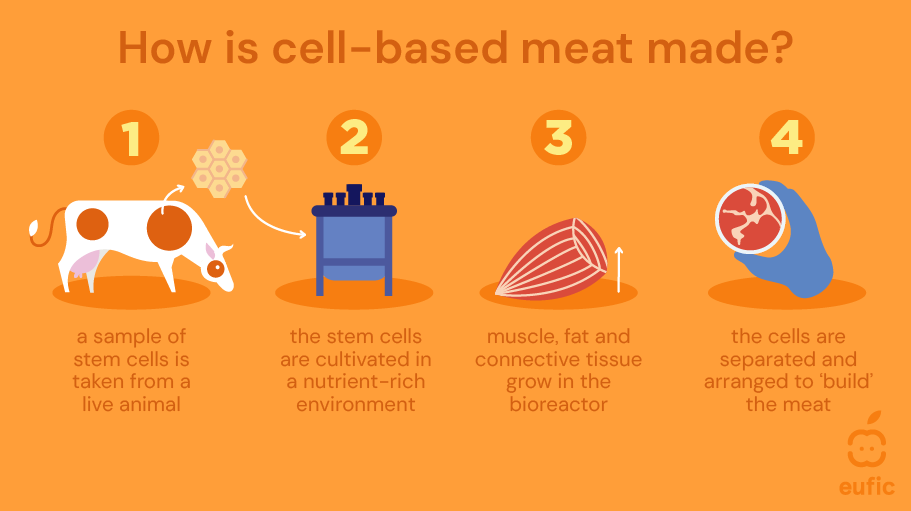Cell-based meat and other cell-based foods: how it is made and what are the pros and cons
Last Updated : 03 December 2025Key takeaways:
- Cell-based foods (also called cultivated or lab-grown foods) are made by growing animal, plant or microbial cells in controlled conditions, rather than raising animals or crops in the traditional way.
- Cultivated meat is produced from animal cells. Its production involves taking a small sample of cells, growing them in nutrient-rich media, and organising them into muscle, fat or other tissues.
- Potential benefits of cell-based meat include reduced need for animal farming, improved animal welfare, and possibly fewer food-borne pathogens. But safety assessments are essential, as contamination risks still exist.
- The environmental impact of cell-based meat remains uncertain. While cultivated meat could use less land and water, it currently requires high energy inputs, and long-term climate effects depend heavily on renewable energy use.
- No cell-based foods are yet approved in the EU, but several products have been authorised elsewhere (e.g., Singapore, USA, Israel, Australia/New Zealand), and regulatory assessments are underway globally.
- Consumer acceptance of cell-based meat remains low, and important questions about taste, nutrition, cost and labelling still need to be answered before these products reach supermarkets.
There has been a lot of talk about lab-grown meat (also called cultivated or cell-based meat) in the news recently. This article explains what it is, how it’s made, and the barriers that will need to be overcome if we’re ever going to find it in supermarkets in Europe.
What are cell-based foods?
Cell-based food is produced from cells isolated from animals, plants or microorganisms to produce food products. There is a growing trend to use the term “cellular agriculture” to describe the production of foods from animal or plant cells rather than from traditional agriculture. Foods produced by this form of technology are comparable to the existing animal products, such as meat, aquatic, dairy and plant products.
Cell-based foods are produced by a well-established technology of cell-culture. Specialised cells (stem cells) are isolated from animals or plants and are placed in a nutrient rich growth medium where they are grown under controlled conditions. Here they develop into animal muscle or fat cells or plant products such as chocolate. The type of cell-based food will depend on the original stem-cell. For instance, stem-cells from eggs are used in the production of chicken nuggets and stem-cells from the cocoa plant are used in the production of chocolate.
What is cell-based meat and how is it made?
An example of cell-based food is cell-based meat that refers to meat developed from animal cell culture, and not via traditional raising and slaughter of living animals.1 It is not an imitation of meat made with other ingredients, like plant-based burgers that are made from plant-based proteins.
The production process can be broken down into four steps:1
- A sample of stem cells is taken from a live animal. Stems cells are cells that can develop into other specialised types of cells found in the body, for example, blood, liver or muscle cells.
- The stem cells are put in large tanks called bioreactors, containing culture media that recreate a similar environment to that which the cells would find in the animal’s body and provides them with the nutrients they need to multiply.
- The culture media is changed so that stem cells can differentiate into the three main components of meat: muscle, fat, and connective tissue.
- These cells are separated and arranged to “build” the type of meat that is being produced. This is called scaffolding. A scaffold is an edible material that supports the organisation of meat cells into the desired shape, for example, a steak, or mincemeat. The scaffold does more than just hold cells together. It also carries nutrients and helps them differentiate even further. In general, complex structures like steaks are more challenging to reproduce than burgers.
This general production process is also used to produce products like chicken nuggets2, foie gras3,4, and chocolate.5 In recent years in Europe, we are seeing a rapid investment and growth in the cell-based food sector that will likely lead to the increased availability of these products on the market.6

Fig. 1 – How is cell-based meat made?
What are some pros and cons of cell-based meat?
Animal welfare is one reason for producing lab-grown meat. This production method can produce meat without the need for raising and slaughtering a large number of animals and therefore, has the potential to increase animal welfare within the food system.7 However, the process currently still relies on stem cells obtained from a live animal, and the most widely used culture medium contains fetal bovine serum (FBS), which is collected from foetal blood at animal slaughterhouses, so it is not yet entirely slaughter-free.8
Some advocates of lab-based meat also consider improved food safety as an advantage of lab-grown meat. This is because, in the controlled lab environment, meat products will not face the traditional risk of contamination with illness-causing bacteria like E.coli or Campylobacter, which usually come from the gut of livestock. However, as with any industrial food production, microbiological or chemical contamination can still occur at different stages. Thorough safety assessments will be needed before they can be sold in Europe.9
More sustainable production of protein will be crucial in the next 30 years, considering that the world population is expected to grow to 9 billion by 2050 and sustainability is an important motivation to produce lab-grown meat. However, it is not clear yet whether mass-scale production of meat in the lab will be more environmentally sustainable than traditional animal husbandry. While less of some resources such as water, land and fertilizers, are needed compared to what is needed to grow feed crops and livestock,10,11 other aspects are more complicated. For example:
- While a reduction of cattle farming would decrease methane emissions that contribute to climate change, recent modelling studies have suggested that lab-based meat production could generate problematic levels of CO2 emissions over the long term.12
- Producing cultivated meat requires significant energy input, which could pose a problem if fossil fuels are used to power the production process. The use of renewable energy will be key to addressing sustainability issues.12
Is cell-based meat suitable for vegetarians or vegans?
Cell-based meat is an old food produced in a new way, which raises a few questions. In the early days, vegans and vegetarians would have rejected cell-based meat completely, because it used foetal bovine serum (FBS) as the growth medium. However since then, companies have been working to replace FBS with a growth medium that doesn’t come from animals, and this was achieved for the first time in 2022.13 While cell-based meat is still considered meat, those who refuse to eat meat for animal welfare reasons may choose to eat it when produced in this way.
Is it likely that human breast milk can be produced using cell-based technology?
The production of cell-based breast milk is an area of active research with a focus of replacing or improving the nutritional quality of powdered infant formula.14 While breast feeding is the best possible option for infants, cultivating mammary cells may offer a product with nutritional characteristics closer to the unique composition of human breast milk. However, current scientific opinion is that cell-based human milk products are unlikely to truly replicate the composition and health benefits of human milk.15
Is cell-based meat halal/kosher?
Singapore was the first country to approve the marketing of a cell-based chicken product. In February 2024, the Fatwa Committee of Singapore issued religious guidance that addressed the issues of consumption and production of cell-based meat. The Fatwa Committee stated that, assuming the right conditions are fulfilled, cultivated meat is generally halal or permissible to be consumed by Muslims.16 Similarly, the Fatwa Council of the United Arab Emirates approved the manufacture and consumption of proteins derived from cell-based meat provided that the animals from which the cells are derived have been lawfully slaughtered according to Islamic regulations.17However, there is still an active debate regarding the conditions for approving cell-based food as suitable for Muslims.18
In January 2024, Israel became the first country in the world to authorise the marketing of a cell-based beef product. The religious authorities in Israel ruled that this cell-based meat product was kosher and pareve (neither meat nor dairy) because the meat was grown from stem cells taken from a fertilised egg rather than cells extracted from muscle tissue.19
Is cell-based meat approved in the EU?
As cell-based foods are classified as novel foods under EU food regulations, the European Food Safety Authority (EFSA) is required to carry out a scientific risk assessment for these products by evaluating their safety before they can be authorised for sale in the EU. In Europe, before a novel food can be placed on the market, it must be approved by the European Commission. To date, no cell-based foods have been approved in the European Union.
There are, however, a number of cell-based foods on the market outside the EU. The UK has approved a cell-based chicken product as an ingredient in pet food.20 Cell-based chicken products (chicken nuggets) have been approved in Singapore and the USA. The USA has also approved a cell-based salmon product for sale.21 Israeli has approved a cell-based beef product and in Australia/New Zealand a cell-based quail foie gras has been approved.22
It is too soon to know whether cell-based meat will be labelled as ‘meat.’ In the EU, the legal definition of meat (which was created when animals were its only possible source) is ‘skeletal muscle deriving from specified animal species.’ In the case of cultivated meat, however, there is no animal and no skeleton, so it’s not clear if the existing definition will be sufficient to cover cell-based meat or not. At the moment, labelling of cell-based meat is under review in the United States where a public consultation is underway.23
Will cell-cultured meat replace traditional meat?
If cell-based meat is going to replace a significant percentage of the meat that we eat, consumer acceptance will be key. Current studies indicate that people are still quite reluctant to accept cultured meat, although acceptance can be increased by the way information about the product is presented.24 For now, people seem more likely to prefer plant-based options when considering alternative proteins.24 However, most available consumer research on cell-based meat is based upon hypothetical situations and very few consumers have had the opportunity to taste cultivated meat so far. There are not many studies on the sensorial properties, so we don’t have much information about how the taste and texture compares to traditional meat.25
It is also difficult to say whether the nutritional value of these novel products will be the same. The reason for the uncertainty is that producing cell-based meat is complex and expensive and most of the knowledge is owned by the companies who have invested in developing the technology. There are not many samples available for independent researchers, so much of the available data is so far either theoretical or based on information provided by start-ups themselves.26
While there are many questions still to be answered about cell-based, EFSA has announced an increased focus on cell-culture derived foods, which may be a step towards paving the way to finding these products on European supermarket shelves.
References
- Post MJ, Levenberg S, Kaplan DL et al., (2020) Scientific, sustainability and regulatory challenges of cultured meat. Nature Food 1:403-415
- Good Food Institute Asia Pacific. (2020). World’s first approval of cultivated meat sales. Accessed 12 November 2025.
- ABC News. (2025). Lab-grown meat approved for sale in Australia. Accessed 12 November 2025.
- Food Standards Australia New Zealand. (2025). A1269 Approval report. Accessed 12 November 2025.
- FoodNavigator-USA. (2025). Mondelez-backed Celleste Bio debuts cell-cultured chocolate-grade cocoa butter. Accessed 12 November 2025.
- Good Food Institute Europe. (2023). State of the European alternative protein research ecosystem: Publications 2020–2024. Accessed 12 November 2025.
- Bhat ZF, Kumar S, Fayaz H. (2015). In vitro meat production: Challenges and benefits over conventional meat production. Journal of Integrative Agriculture 14(2):241–248.
- Chriki S, Hocquette JF. (2020). The myth of cultured meat: A review. Frontiers in Nutrition 7:7. doi: 10.3389/fnut.2020.00007
- Ong KJ, Johnston J, Datar I, et al. (2021). Food safety considerations and research priorities for the cultured meat and seafood industry. Comprehensive Reviews in Food Science and Food Safety 20(6):5421–5448.
- Mattick CS, Landis AE, Allenby BR, et al. (2015). Anticipatory life cycle analysis of in vitro biomass cultivation for cultured meat production in the United States. Environmental Science & Technology 49(19):11941–11949.
- Tuomisto HL, Teixeira de Mattos MJ. (2011). Environmental impacts of cultured meat production. Environmental Science & Technology 45(14):6117–6123.
- Lynch J, Pierrehumbert R. (2019). Climate impacts of cultured meat and beef cattle. Frontiers in Sustainable Food Systems 3:5. doi: 10.3389/fsufs.2019.00005
- Messmer T, Klevernic I, Furquim C, et al. (2022). A serum-free media formulation for cultured meat production supports bovine satellite cell differentiation in the absence of serum starvation. Nature Food 3:74–85.
- Turrell C. (2024). Lab-grown breast milk. Nature Biotechnology 42:1759–1761.
- Food Regulation Australia and New Zealand. (2024). Issues paper: Food regulatory framework considerations for cell-based human milk products. Accessed 12 November 2025.
- Majlis Ugama Islam Singapura (MUIS). (2024). Fatwa on cultivated meat. Accessed 12 November 2025.
- Green Queen. (2025). Lab-grown cultivated meat & Islam: Can Muslims eat it? Halal ruling explained. Accessed 12 November 2025.
- Shuhaidi BNMK, Rosidi MH. (2025). From lab to table: Islamic jurisprudential analysis of cultured meat production.
- United States Department of Agriculture (USDA). (2024). Israeli Government finds cultivated beef to be safe for human consumption. Accessed 12 November 2025.
- FoodNavigator. (2024). Meatly gets UK approval for use of cultivated meat in pet food. Accessed 12 November 2025.
- Just Food. (2025). FDA clears Wildtype salmon. Accessed 12 November 2025.
- Good Food Institute Asia Pacific. (2025). Regulators approve cultivated meat sales in Australia. Accessed 12 November 2025.
- United States Department of Agriculture (USDA). (2021). Labeling of meat or poultry products comprised of or containing cultured animal cells. Accessed 12 November 2025.
- Pakseresht A, Kaliji SA & Canavari M. (2022). Review of factors affecting consumer acceptance of cultured meat. Appetite 170:105829.
- To KV, Comer CC, O’Keefe SF & Lahne J. (2024). A taste of cell-cultured meat: A scoping review. Frontiers in Nutrition 11:1332765.
- Fraeye I, et al. (2020). Sensorial and nutritional aspects of cultured meat in comparison to traditional meat: Much to be inferred. Frontiers in Nutrition 7:35.

